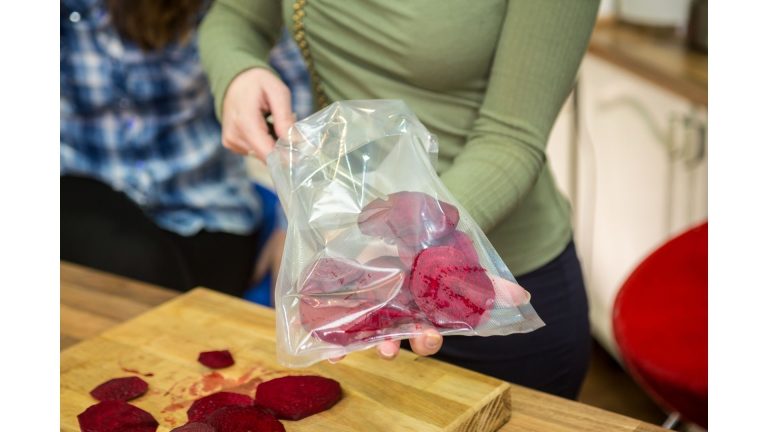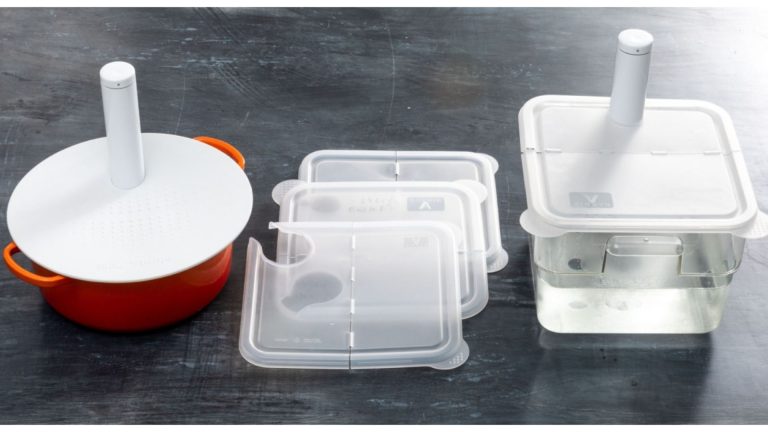How Long to Sous Vide Ribeye
If you want to cook a steak with perfect edge to edge, sous vide is the perfect way to cook it. The steaks can be finished in a pan or on the grill.
Highly marbled cuts like a grain-finished prime-grade ribeye and strip should be cooked a few degrees higher than leaner steaks like tenderloin since there are plentiful fats that help to keep moist while delivering plenty of flavors.
Ribeyes and strip steaks should be cooked medium-rare to medium, around 130F / 54C to 135F / 57C.
Fattier steaks will take slightly longer to reach the correct internal temperature because they have natural insulation.
Timings are given for steaks that are one-and-a-half to two inches in thickness.
The initial cooking time can be shortened to 40 minutes for steaks less than one inch.
Steaks should not be cooked for more than two-and-a-half hours at a time due to food safety reasons.
- Very Rare to Rare: 120°F / 49°C to 128°F / 53°C;1 to 2 1/2 hours.
- Medium-rare: 129°F / 54°C to 134°F / 57°C;1 to 4 hours.
- Medium: 135°F / 57°C to 144°F / 62°C;1 to 4 hours.
- Medium-well: 145°F / 63°C to 155°F / 68°C; 1 to 3 1/2 hours.
- Well done: 156°F / 69°C and up; 1 to 3 hours 2 1/2 hours max if under 130°F / 54°C.
Table of Contents
Ribeye Sous Vide Recipe
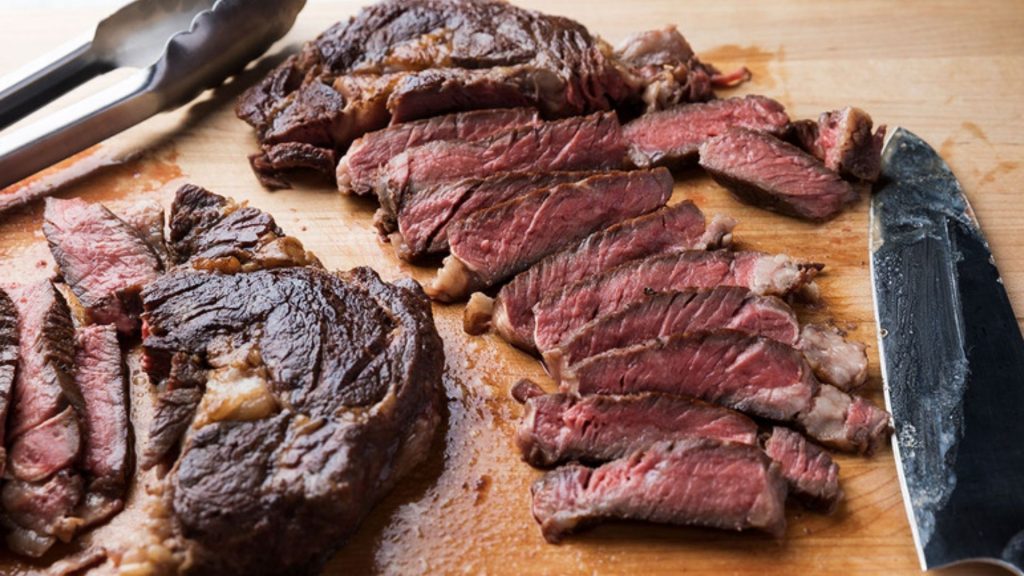
Ingredients Used
- 1 1/2-to 2-pounds / 680 to 900 grams bone-in or 1 to 1 1/2-pounds / 450 to 680 grams) boneless steaks (1 large ribeye)
- Kosher salt and freshly ground black pepper to taste
- 2 fresh thyme sprigs (optional)
- 2 fresh rosemary sprigs (optional)
For Finishing Steps:
- 1 tablespoon / 15 ml vegetable, canola, or rice bran oil
- 1 tablespoon / 15 ml unsalted butter
- 3 to 4 fresh thyme sprigs (optional)
- 3 to 4 fresh rosemary sprigs (optional)
- 1 small shallot, sliced (optional)
- 2 whole cloves garlic, smashed (optional)
- Coarse sea salt (such as Maldon) to finish
Steps to Follow
- Preheat your sous vide cooker to the desired final temperature.
- Allow the water bath to come to a temperature before adding your steak.
- If you’re going to cook and eat them immediately, season liberally with salt and pepper and put them into a bag or vacuum-sealed container.
- Salt and pepper will be added later on if you seal now to freeze or cook for later.
- You can use aromatics like thyme or rosemary sprigs, add them to the bag now, distributing them evenly on both sides of the steak.
- Seal the bag with a vacuum sealer or you can use a ziploc bag. Use the water displacement method here.
- Drop the bag in the water bath to make sure you don’t block the intake or output sections of your Precision Cooker. The steak should not sink if it is properly sealed.
Finishing steps:
Stovetop
- Remove the steak from the bag and pat with a paper towel to remove all the moisture. If you haven’t seasoned your steak before you can now season it with salt and pepper.
- Open your windows if you want to turn on your vent.
- Place a heavy cast-iron or stainless steel skillet with a small amount of vegetable, canola, or rice bran oil over the hottest burner you have and preheat it until it started smoking.
- You can place the steak in the skillet using your fingers or tongs. Add a small amount of butter if you want.
- Milk solids in the butter will blacken and char, helping your steak to achieve a dark crust much faster and adding a characteristic slightly bitter, charred flavor.
- This flavor is typical of a steakhouse experience, and I like it. The butter should not be used at this stage for a cleaner-tasting sear.
- If you like you can add aromatics like thyme and rosemary sprigs with the leaves still attached, sliced shallots, or crushed whole garlic cloves.
- After 15 to 30 seconds, flip the steak to get the second side in contact with the pan.
- When the steak has developed a nice brown sear, flip it every 15 to 30 seconds. If you did not add butter previously, add now to the skillet and do it for 30 seconds.
- Pick up the steak and rotate it so that the edge of the skillet is in contact with it. Continue to cook, rotating the steak until all of the edges are blackened. This will take about 40 seconds.
- Transfer the steak onto the wire rack. If you are ready to serve, reheat any fat and juices left in the pan until it starts sizzling.
- Then pour them over the steak to re-crisp and moisten the surface.
- The steaks can be served immediately if you are ready, no need to rest sous vide steak.
- You can serve the steak with salts like Maldon.
Stovetop with a torch
- Remove the steak and place it on a paper towel. Pat, it dries carefully on both sides. If you did not season before, season it now generously with salt and pepper.
- Open your windows after turning on the vents.
- Place a heavy cast-iron or stainless steel skillet with a small amount of vegetable, canola, or rice bran oil over the hottest burner you have and preheat it until it starts smoking.
- You can place the steak in the skillet using your fingers or tongs. Add a small amount of butter if you want.
- Milk solids in the butter will blacken and char, helping your steak to achieve a dark crust much faster and adding a characteristic slightly bitter, charred flavor.
- This flavor is typical of a steakhouse experience, and I like it. The butter should not be used at this stage for a cleaner-tasting sear.
- If you like you can add aromatics like thyme and rosemary sprigs with the leaves still attached, sliced shallots, or crushed whole garlic cloves.
- Now flip the steak and start torching until it turns pale brown with a few black spots. This will take about 30 seconds.
- Now flip the steak to the second side and start torching it until it turns pale brown.
- You can add butter here to increase its richness and texture.
- Pick up the steak and rotate it so that the edge of the skillet is in contact with it. Continue to cook, rotating the steak until all of the edges are blackened. This will take about 40 seconds.
- Transfer the steak onto the wire rack. If you are ready to serve, reheat any fat and juices left in the pan until it starts sizzling.
- Then pour them over the steak to re-crisp and moisten the surface.
- The steaks can be served immediately if you are ready, no need to rest sous vide steak.
- You can serve the steak with salts like Maldon.
Grilling
- When all the charcoal is lit and covered with gray ash, arrange the coals on the side of the grate that is closest to the chimney.
- Allow the grill to preheat for five minutes after setting the cooking grate in place.
- Alternatively, set half the burners on a gas grill to the medium heat setting, cover, and preheat for ten minutes.
- Remove the grill grate with a grill scraper, then rub it with a set of tongs and hold an oil-dipped kitchen towel or paper towels in a set of tongs and rub them over the ribs.
- Remove the steak and place it on the paper towel and pat dry it.
- Rub gently with canola, vegetable, or rice bran oil.
- You can add salt and pepper if you haven’t seasoned it before.
- Now place the steaks on the hot side of the grill and cook it for 30 seconds until a rich crust is formed.
- Now transfer this teak onto the cooler side of the grill until the flames subside.
- Remove the steak from the grill and serve immediately.
FAQ
Does Timing Matter for Sous Vide Steak?
In theory, timing matters less when you’re cooking food in the water bath than when you’re searing your steak on the grill.
But in practice, there are plenty of factors that affect the cooking time for steak sous vide, like meat type, thickness, and marinating time.
Start by choosing a safe temperature and time range. And if you want a more precise measurement, try a meat thermometer.
You can also use the digital temperature display built into your kitchen microwave.
What happens if I leave a steak cooking sous to vide for longer than the maximum time recommendations?
The steak will likely taste good, but it won’t be cooked to perfection. This is due to the nature of the cooking process.
As the steak heats, the water inside the food begins to boil; once the boiling point is reached, it will continue cooking until the inside of the food is completely warm.
If you’ve left your steak cooking for the full amount of time, it may not have reached this point yet, and you could end up with an overcooked steak.
Can I cook a steak straight from the freezer?
Yes, but you’ll be sacrificing flavor. The process of defrosting makes the meat more water- and air-permeable, which allows the natural juices to escape.
A better option is to partially thaw your steak in the fridge overnight before cooking. This will slow down the cooking process and result in a juicier steak.
Or, if you prefer to cook straight from the freezer, just leave the steak in the original bag for 30 minutes before cooking.
What is the Time and Temperature to Sous Vide a Ribeye Steak?
Here’s what you do: Preheat the oven to 300 degrees F. Place an 8-ounce glass baking dish inside a larger oven-safe container with a lid (such as a stockpot).
Place the rib eye steak in the glass baking dish, top with 1-inch of water, cover the pan with the oven-safe container lid, and bake for 45 minutes.
Remove from the oven and remove the lid.

Foodie and a passionate cook, I am here to share all of what I know about cooking, kitchen, and food prepping.
Follow me for delicious and healthy recipes.

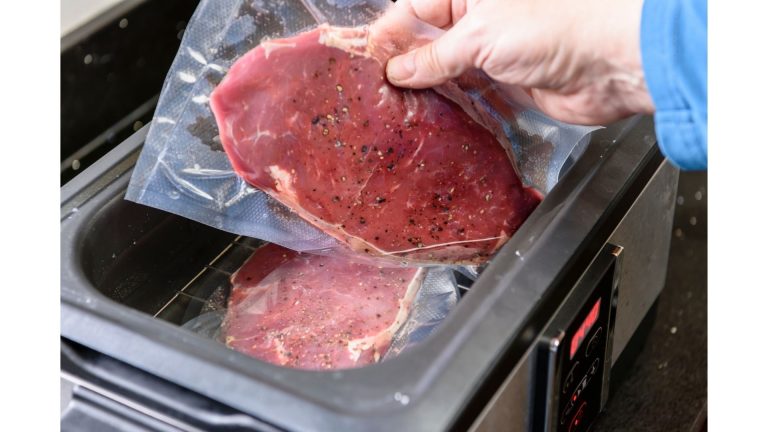
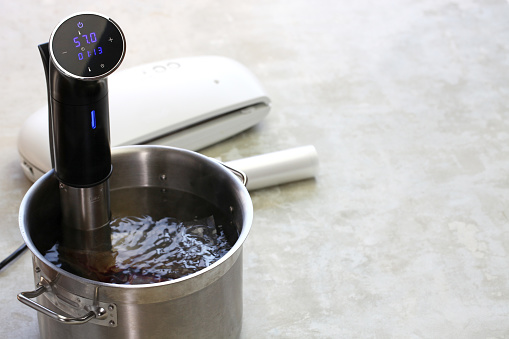
![Best Steak Cut for Sous Vide [Guide]](https://jikonitaste.com/wp-content/uploads/2022/02/best-steak-cut-for-sous-vide-768x432.jpg)

